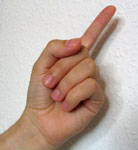1 (number)
1 (One) is the first natural number, followed by two. The Roman numeral for one is I.
| ||||
|---|---|---|---|---|
| Cardinal | one | |||
| Ordinal | 1st (first) | |||
| Factorization | 1 | |||
| Divisors | 1 | |||
| Roman numeral | I | |||
| Roman numeral (unicode) | Ⅰ, ⅰ | |||
| Greek prefix | mono- /haplo- | |||
| Latin prefix | uni- | |||
| Binary | 12 | |||
| Ternary | 13 | |||
| Quaternary | 14 | |||
| Quinary | 15 | |||
| Senary | 16 | |||
| Octal | 18 | |||
| Duodecimal | 112 | |||
| Hexadecimal | 116 | |||
| Vigesimal | 120 | |||
| Base 36 | 136 | |||
| Greek numeral | α' | |||
| Persian | ١ - یک | |||
| Arabic | ١ | |||
| Urdu | ||||
| Ge'ez | ፩ | |||
| Bengali & Assamese | ১ | |||
| Chinese numeral | 一,弌,壹 | |||
| Korean | 일, 하나 | |||
| Devanāgarī | १ | |||
| Telugu | ೧ | |||
| Tamil | ௧ | |||
| Kannada | ೧ | |||
| Hebrew | א (alef) | |||
| Khmer | ១ | |||
| Thai | ๑ | |||
| Malayalam | ൧ | |||

Mathematics
In mathematics, 1 is the multiplicative identity. It is sometimes called the "unity".[1] It is also the only number for which these special facts are true:
- Adding one to a number always gives one greater than that number. For example, adding one to three gives four. In symbols:
3 + 1 = 4
- Subtracting one from a number always gives one less than that number. For example, subtracting one from three gives two. In symbols:
3 - 1 = 2
- Subtracting a number from one always gives something less than one. For example, subtracting three from one gives negative two. In symbols:
1 - 3 = -2
- Multiplying a number by one always gives that number. For example, multiplying three by one gives three. In symbols:
3 × 1 = 3
- Dividing one by a different number always gives the reciprocal of that number. For example, dividing one by three gives one third. In symbols:
1 ÷ 3 = 1/3
- Dividing a number by one always gives that number. For example, dividing three by one gives three. In symbols:
3 ÷ 1 = 3
- Dividing a different number by itself always gives one. For example, dividing three by three gives one. In symbols:
3 ÷ 3 = 1
In mathematics, 0.999... is a repeating decimal that is equal to 1. Many proofs have been made to show this is correct.[2][3]
Computer science
The number one is important for computer science, because the binary numeral system uses only 1s and 0s to represent numbers. In machine code and many programming languages, one means "true" (or "yes") and zero means "false" (or "no").
Other meanings
- In Germany and Austria, one is the grade for "very good". It is the best grade of six possible grades in Germany, and the best of five possible grades in Austria. In the Netherlands, one is the lowest grade, and ten the highest. In Poland, one is also the lowest grade, and the highest is six.
- In numerology, the number one is a symbol for everything (unity), the beginning, and God.
1 (number) Media
The 24-hour tower clock in Venice, using J as a symbol for 1
Hoefler Text, a typeface designed in 1991, uses text figures and represents the numeral 1 as similar to a small-caps I.
Related pages
References
- ↑ Weisstein, Eric W. "1". mathworld.wolfram.com. Retrieved 2020-09-22.
- ↑ Byers, William (2007). How Mathematicians Think: Using Ambiguity, Contradiction, and Paradox to Create Mathematics. Princeton UP. pp. 39–41. ISBN 978-0-691-12738-5.
- ↑ Richman, Fred (December 1999). "Is 0.999... = 1?". Mathematics Magazine. 72 (5): 396–400. doi:10.2307/2690798. JSTOR 2690798. Free HTML preprint: Richman, Fred (June 1999). "Is 0.999... = 1?". Archived from the original on 2 September 2006. Retrieved 23 August 2006. Note: the journal article contains material and wording not found in the preprint.